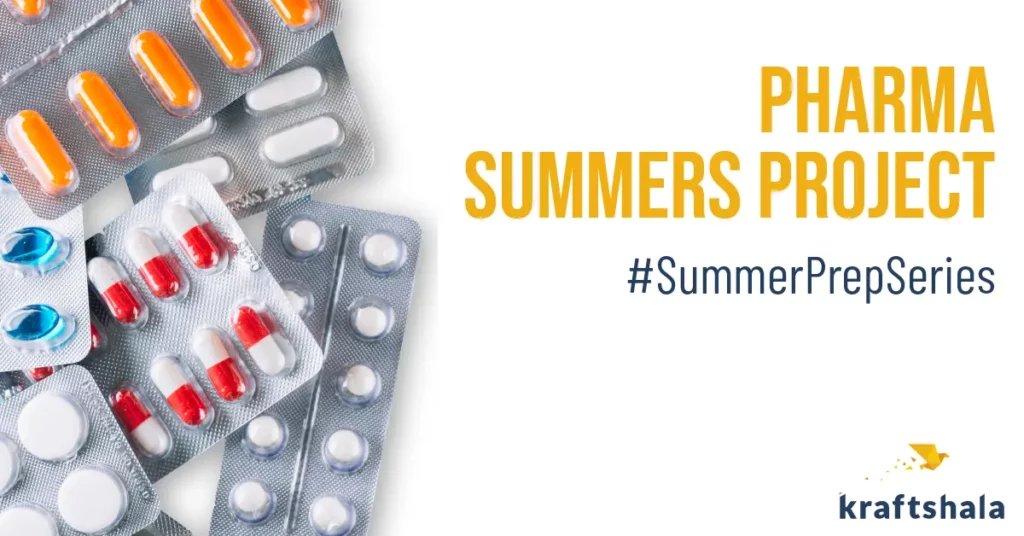
With this summer prep series, we want to help you crack a PPO in your summers. And if your summers is in pharma, you’re at the right place.
Pharma sector is at the forefront of cutting-edge technology from gene-splicing to 3D printed organs, the sector pushing the boundaries of life expectancy as we know it. And companies like Glenmark, Cipla, Pfizer, Biocon are leading the way. A career in Pharma gives you a chance to be a part of the healthcare transformation in the world.
To help you with this, we are going to decode a project to give you an idea about how to approach your summers project in Pharma.
Without further ado, let’s deep dive into the Pharma project.
Summer Internship Project:
Conduct market research to determine the cause of low usage and subsequently low sales of the TIOVA Inhaler used to prevent and cure COPD disease. Provide recommendations to increase usage and sales.
Project Brief
Chronic obstructive pulmonary disease (COPD) is a chronic inflammatory lung disease that causes obstructed airflow from the lungs. It is majorly caused due to life style problems such as chronic exposure to toxins in the air for long periods of time. Women in rural areas who cook food over a traditional ‘chula’ and chemical factory/mine workers are often victims of the disease. Chain cigarette smokers make up a minority of the populace affected by the disease. Cipla’s drug TIOVA taken through a respiratory inhaler is a preventive and curative solution to COPS. However, sales of the drug have been low and stagnant in spite of over 30 Mn COPD patients in India. Ripla, being the market leader in respiratory related drugs seeks a solution to this issue through extensive market research of the main causes of low usage and sales.
Objective and Deliverables
- Study the market for respiratory disease medicines
- Understand the sales channel in the Pharma sector
- Conduct primary research by meeting and interviewing doctors to gauge why TIOVA is not being prescribed. Gauge reasons for low usage from the end consumer’s end.
- Suggest ways to increase awareness of COPD, TIOVA among customers (doctor’s) and consumers (patients)
- Propose strategies to increase sales of TIOVA
Approach
- The first phase of the project consisted of theoretically understanding the COPD disease, TIOVA as a drug. This was done by studying information packets provided by RIPLA and also secondary research of medical journals and blogs. The present market scenario of COPD battling drugs was studied, and it was found that lower usage of drugs and low sales was not just a RIPLA specific issue but an industry wide issue. This conclusion was drawn from interacting with the sales team and researching drug sales databases.
- The sales channel of Pharma as a sector was studied by shadowing an MR (Medical Representative) on their territory assigned visits to doctors. The sales pitch of MRs was closely studied on 3 days of field visits in the Mumbai geography. Each day of the field visit consisted of meeting 8-10 doctors and pitching RIPLA drugs to them. The average time spent with each doctor was 2-3 minutes and sometimes a 20 second pitch was all that was entertained by busy doctors.
- In the next phase of the project a questionnaire for doctors was designed to understand the cause of low prescriptions of TIOVA. This survey was designed in collaboration with the internal medical teams as well as the marketing department to bridge the gap between scientific data to gain managerial insights. The survey consisted of MCQ as well as open ended questions about COPD patients, their behavior and doctors’ recommendations to them.
- Since the research had to be carried out on a large scale, before floating the extensive survey, a pre-research survey was also designed in order to test whether the results obtained would generate valid insights. This pre-research survey was floated locally to 30 doctors.
- On analysing the pre-research survey results, it was found that no particular trend/reason could be established for the reason of low prescriptions. A hypothesis was formed that the doctors had not carefully answered the questions as per their best judgements. Basis this hypothesis, the main research survey was redesigned to incorporate similar questions occurring at regular intervals phrased in different ways, similar to a psychometric test.
- On floating the extensive research survey to 400+ doctors, those survey forms with consistent responses on similar questions were accepted to be valid responses and the others were rejected as invalid. The research was carried out across 8 cities in the states of Maharashtra, Telengana, UP and Delhi with the assistance of an external market research agency.
- On analysing the survey data obtained through excel and also interacting personally with more than 50 doctors 3 key reasons were establish for low TIOVA prescription and usage.
Stakeholders
Internal: Respiratory specialists at RIPLA, medical representatives, marketing team, sales team, finance team & legal team
External: Doctors & patients
End Result
Reasons for doctors not recommending TIOVA
- Problem identified: The symptoms of COPD are similar to that of Asthama. Hence, COPD is often confused with Asthama which has more awareness in the medical community and the general populace. To differentiate COPD from Asthama, a spirometer device is required for diagnosis which is capital intensive and not present in small doctors’ clinics. In the past, micro spirometers were developed by CIPLA and distributed free of cost to doctors as part of a pilot project, which too failed promoting usage by doctors.
- Solution suggested: A pain point for doctors recognized from the survey, was the long time it took for diagnosis using a spirometer. A suggestion to combat this pain point was training MRs to carry out the diagnosis at the doctors’ site. This solution was not scalable as determined by a pilot. This was due to uneven MR resource allocation, which could not be optimized. The most feasible and scalable option was to outsource diagnosis and partner with diagnostic centers. The partnership of CIPLA with 2 leading diagnostic centers was being worked upon towards the end of the internship.
- Problem identified: Doctors initially prescribe Asthma medicines to COPD patients which contain a steroid component that provides temporary relief to patients but is not a long term solution. Patients do not re-visit the doctor and keep buying the Asthama medicine in irregular doses to get momentary relief. This is harmful for long term well-being.
- Solution suggested: Changing the line of communication by MRs about TIOVA to doctors. The 1st line of communication requires initial screening and proper pinpointing of disease through diagnosis followed by prescription recommendation. TIOVA was recommended only to COPD patients who returned to doctors when Asthama medicines failed them. With the 1st line of communication doctors would prescribe TIOVA to all patients who are tested positive for COPD from the get-go, without requiring a revisit by the patient.
Reasons for patients not using TIOVA:
- Problem identified: Affordability of the medicine was a key issue. COPD can be termed as a ‘poor person’s disease’ since it is caused by long term exposure to toxic that can be attributed to lifestyle. A chronic COPD patient had to take a dose of TIOVA every day and this inhibited people from purchasing the medicine.
- Solution suggested: Bundle pricing inspired from the FMCG sector was suggested. Monthly packs for the medicine could be sold cheaper than daily doses. The pricing revamp on larger packs that could break bulk was suggested to the finance team.
Challenges
- Since the project was primarily market research based, the key challenges was seeking doctors to interview in order to get to the root cause of low prescription numbers. Doctors are busy people saving lives and it was expected that they would not have time to answer questions of an intern. Waiting outside doctors’ cabins for 2-3 hours was common as was being turned away by some. Patience and persistence were the two qualities that came in handy to battle this challenge. Instead of directly jumping to the topic of TIOVA and its low prescriptions, doctors were first asked about their views on COPD in general and the research was framed more like a conversation and dialogue than a question and answer format. Doctors were addressed not from the perspective of a student conducting research for an internship but as an employee of RIPLA.
- Another challenge was training the MRs on the new line of communication to be used while introducing TIOVA to doctors. MRs had to unlearn what they already knew in the form of their sales pitch and had to relearn a new pitch. Building relationships with them and involving them in the project not just as front line salespeople but as relevant stakeholders whose opinions mattered, helped in this regard.
End Review Questions
Project specific
- Rate your three suggestions on a priority basis for RIPLA.
- What changes did you make to the survey after the pre-market research?
- How did you manage to get doctors’ time and attention?
- What were some questions that were asking in the research survey to doctors?
- What according to you is the best technique for primary research?
HR + General questions
- If you could redo the internship would you do anything different?
- Why do you want to work at RIPLA?
Now this is just one type of project you might get. Although, projects across sectors tend to have a lot in common. So make sure, you keep an eye out for other sector projects as well.
This article was written by Sneha Roy from FMS.
Check out our courses











